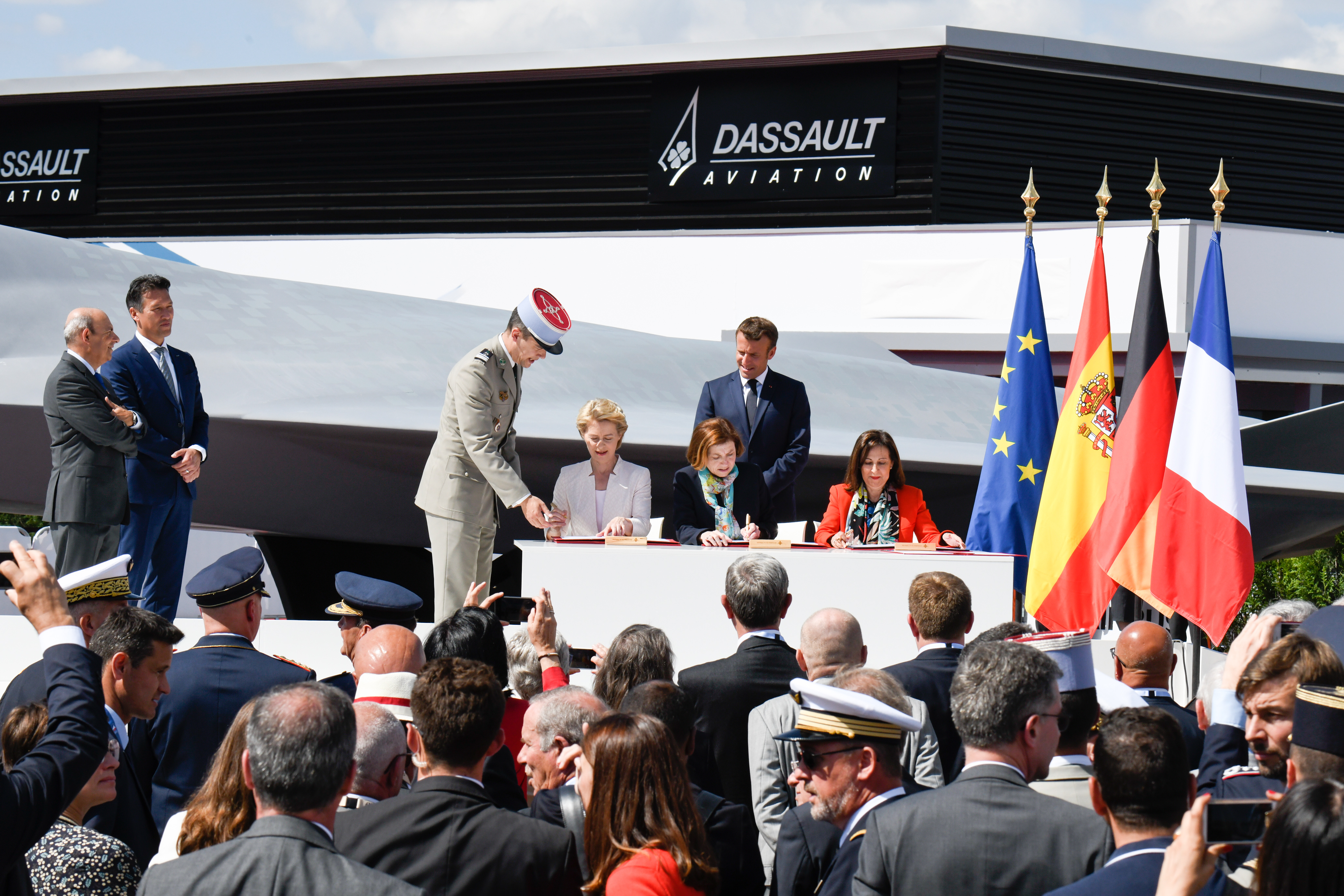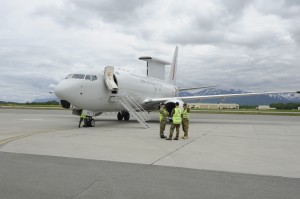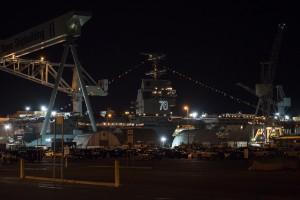The Combat Cloud at the Heart of the Future Combat Air System
Paris – A ministerial signing ceremony at the June 17 opening of the Paris air show marked Spain’s joining France and Germany in the Future Combat Air System project, as the industrial partners made an offer for a study for demonstrators for a stealthy new fighter, drones and an advanced network of systems.
President Emmanuel Macron, in dark blue suit and tie, stood just behind the French, German and Spanish ministers as they signed the three-nation pact, the high point of the official opening of the Paris air show at Le Bourget airport.
The official diary of Macron showed the head of state was host at the Elysées presidential office for dinner with top industry executives, on the eve of the show, which seeks to showcase the global aeronautical and space industry.
Airbus and Dassault Aviation have submitted a joint proposal for studies in the first demonstrator phase, expecting to sign a contract with the French and German procurement offices in the fourth quarter of 2019, the companies said in a statement.
“We have submitted this morning a proposal to the French and German procurement officers… for the study for a technology demonstrator,” Eric Trappier, Dassault chief executive, said in a press conference with Dirk Hoke, chief executive of Airbus Defence & Space. The briefing was held in open air next to a life-size model of the future fighter.
The study for the first demonstrator phase is worth around 100 million euros ($112 million) and runs for 18 months, said Trappier, who declined to give a figure for the total budget for the FCAS program.
Negotiations can begin on the study, with an aim of flying a demonstrator fighter in 2026.
The demonstrator study will examine how best to design and build the new generation fighter, UAVs dubbed remote carriers, and a system of systems. Those manned and unmanned aircraft will be interconnected, key elements in a cybersecure network dubbed combat cloud. The aircraft will also be linked to commanders on the ground.
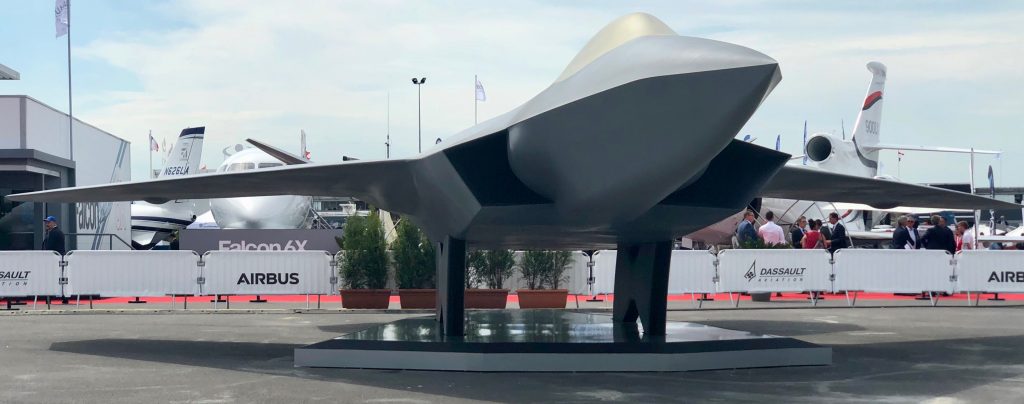
The industrial partners pitch FCAS as a means to maintain European sovereignty and autonomy, requiring government support with industry sharing risk.
Airbus and Dassault are keen for the demonstrator project to take off promptly, and hope France and Germany will agree on common export rules to allow foreign sales.
France and Germany welcomed Spain into the FCAS project, with the three defense ministers signing a framework agreement.
That signing ceremony, soaked in sunshine, took place just next to a a life size mock up of the fighter, which had just been unveiled before the ministers and Macron, and a patient crowd of spectators and journalists.
“This signature sets in marble a key step in the construction of European defense, marrying technological excellence, political will and industrial cooperation,” the French armed forces ministry said in a statement. Florence Parly, Ursula von der Leyen and Margarita Robles respectively signed for France, Germany and Spain.
The model was to show what the fighter might look like, with much depending on the demonstrator, which will explore stealth, manoeuvrability and other key factors.
“That is not the definitive shape but it will resemble something like that,” Trappier said.
Models of two concept weapons were displayed next to the fighter, with one from Airbus, the other from MBDA.
“The minister just reconfirmed five minutes ago a demonstrator should fly in 2026,”
Hoke said. “That is the aim for the studies.”
The first part of the demonstrator project will run from 2019 to mid-2021 and study four areas: the new generation fighter, the engine, the system of systems, and the remote carriers – or drones. There will also be study on simulators for working out operational scenarios.

Teaming agreements have been drawn up with companies including Thales, an electronics company, and MBDA, a missile maker which has worked on drone concepts.
French engine maker Safran and its German partner MTU have signed up to build a new engine, which will eventually power the planned European fighter.
The demonstrator fighter will initially fly with an engine already in operation, which might be a version of the M88 or similar, Trappier said.
The demonstrator fighter will be “very different from a Eurofighter and Rafale,” he said, adding that the plans for the fighter to fly “into denied areas, designed with stealth and manoeuvrability.”
Hoke said, “It is important we start (on) different modules also, what we call combat cloud to define the system of connectivity and also the standard of communication.”
Besides stealth features to evade air defense systems, the fighter will rely on remote carriers flying ahead, seeking to jam defenses, detect and relay information to pilots and ground commanders, Trappier said.
The fighter will be larger and stealthier than the Rafale or Eurofighter, with radar to give 360° coverage, an internal weapons bay and the “capability to be part of the combat cloud,” he added.
There will be onboard artificial intelligence to process big data, inform and present options to the pilot.
“Stealth is one of the key concepts, not the only one, but it is one of the most important,” he said. There will be single seat and two-seat versions, with the latter for complexity of missions, particularly strike missions, rather than solely for training.
The French version of the fighter will be able to carry a nuclear-tipped missile, the successor to the present ASMP/A, and also operate from an aircraft carrier.
Sales of the fighter to other European nations were expected once the fighter was flying, as it would be “better to have this plane than the planes presently flying,” Trappier said. France would pitch the plane to Egypt and Qatar at some point.
Those two countries have ordered the Rafale, along with India.
“Export is a fundamental part of the determination of the two companies and the two nations to boost the production numbers,” he said. “We do not have a domestic market as big as the US, even if there are several countries in Europe.”
Hoke, asked about the German minister calling for a European set of export rules, said, “We favor agreeing first French-German rules. If that serves as a model for Europe, then that is fine.
“It is important to have the rules right from the beginning,” he said. “We need to speed up, but if we agree rules by the mid-2020s, that could be resolved. If we don’t get a bilateral agreement, there will be problems entering the demonstrator phase. We need clarity in exports.”
Trappier said, “We will try to be ITAR-free, not to be dependent on a third country. We need a certain autonomy.”
That was a reference to the US international traffic in arms regulations, which require Washington authorization on sale of equipment to foreign nations.
“It is also a question of sovereignty,” said Hoke. Europe has a right to which system they use, where they use it.”
A lack of common set of export rules also applies to KNDS, the joint venture between Nexter and Krauss-Maffei Wegmann, which will build a new tank, dubbed main ground combat system, which will replace the Leclerc and Leopard 2.
Asked whether Britain might one day join FCAS, Trappier said, “It is a little bit too early to say. Maybe one day. I don’t know, it’s not yet decided. We need really to start the work.” The priority was to have the demonstrator fly in 2026, he added.
Hoke said, “It depends of course largely on how Brexit develops. So it would be premature to discuss this at this stage.”
The UK is pursuing its Tempest program for a future fighter, in which Sweden is showing strong interest as a replacement for its earlier model Gripens, said Sash Tusa, analyst at Agency Partners, a financial research office.
The UK government is investing £2 billion in the fighter project, with industry is putting in around £1.5 billion, he said. That government funding might be found by cutting the order for the F-35 joint strike fighter to 48 units from 136, saving some £8 billion.
“Tempest is an alternative to maintain UK national sovereignty in combat aircraft,” he said, adding that it was reasonable to support two European fighters.
For Richard Aboulafia, analyst at Teal group, the prospect of two new European fighters recalled the early 1980s, with the Tornado and Mirage, while the F-16 came from the US. Back then, there was no pressure from Brexit. Today, there is the F-35 arriving, two new European fighters planned and “compressed time pressure,” he said.
The 20 years of development for FCAS sparks some concern, as this is effectively an additional five years of cost compared to Tempest, increasing the budgetary burden, Tusa said.
The 20 years of development for FCAS sparks some concern, as this is effectively 20 years of cost, raising a budgetary burden, Tusa said.
Trappier said the industrial partners have proposed technology packages, with responsibility clearly set to show what is possible.
“We will be ambitious, we will eliminate risk. The demonstrators will be a way of de-risking,” he said.
“There will be a feasibility study. It will, in theory, take more time but ultimately it will be faster, cost less because there is less risk, easier to fix than to launch full series production and then solve problems,” he said. Industry asked for more room and flexibility, which the governments have granted.
“Industry will assume some of the risk,” he added.
Airbus and Dassault signed in January as joint prime contractors for a two-year joint concept study worth €65 million for FCAS. In France, Thales, Safran and MBDA signed up for the study, while in Germany, Hensoldt, ESG, Diehl Aero, MBDA and Rohde & Schwarz, and MTU signed.
The featured photo:
Emmanuel Macron, President de la Republique, Florence Parly, ministre des armÈes francaises, Ursula von der Leyen, ministre de la defense de l’AllemAgne, Mararita Robles, ministre de la defense espagnole, Eric Trappier, President du GIFAS, PDG de Dassault Aviation, signature d’un accord cadre pour la construction d’un systeme complet d’avions de combat et de drones, revelation de la maquette en taille reelle du SCAF, futur avion de combat europeen
53eme Salon International de l’Aeronautique et de l’Espace
Editor’s Note: It is not often that one is at the launch of a concept but I did so with regard to the combat cloud.
In a 2014 visit with the then head of the Air Combat Command, General Hostage, along with Lt General (Retired) Deptula, in our discussion launched a concept — the combat cloud. For the ACC Commander, this was his way of discussing how the fifth gen aircraft were impacting the USAF and a way ahead with regard to 4th and 5th generation integration.
Now the FCAS launch is being built around this concept with the emphasis being placed on connectivity as this recent Airbus press release has highlighted.
Airbus tests its Network for the Sky on a MRTT aircraft
13 June 2019 – Airbus has successfully completed a flight demonstration of a connected airborne battlespace scenario, centred on a MRTT aircraft. The test was carried out as part of the development of Airbus’ Network for the Sky (NFTS) programme. This follows on from last August’s demonstration in Canada of secure mobile communications using a stratospheric balloon to simulate a HAPS (High Altitude Pseudo Satellite), such as Airbus’ Zephyr UAV (Unmanned Aerial Vehicle).
NFTS combines various technologies – satellite and ground communications, air-to-ground, ground-to-air and air-to-air tactical links, 5G mobile communications and laser connections – in a resilient, unified, secure, highly interoperable, mesh network. Aircraft, UAVs and helicopters currently use networks with limited bandwidth and interoperability, and often little resilience. NFTS will allow them to form an integral part of high-speed military networks.
“This unique demonstration is a significant milestone in realising our vision of secure connectivity, which will enable the future air combat cloud and enhance real time execution of military missions,” said Evert Dudok, Head of Communications, Intelligence & Security at Airbus Defence and Space.
The demonstration scenario simulates the establishment of multi-Mbit/s, wideband communication links between ground forces operatives, a fighter jet, a MRTT, and a combined air operations centre (CAOC) on the ground. Both the operatives and jet fighter had to send video in real time to provide enhanced real-time situational awareness and receive instructions from the CAOC in return.
The operative located in Getafe (Spain) was equipped with a standard handheld radio for NATO forces (ROVER). The fighter was deployed to obtain imagery of the area of interest and act as a communications node between the operative and the MRTT flying at 30,000 feet within a 150 km radius in secure airspace.
Communications were thus relayed between the fighter jet and the MRTT, via a wideband LOS (line-of-sight) data link. The MRTT then routed the video along with its own communications via a wideband satellite link to a space teleport near Washington, D.C. The communications flow was then returned to Europe via a terrestrial link to the CAOC.
This complex scenario demonstrates the real-time operation of secure end-to-end communications across different networks and technologies: ground-air tactical link, air-air wideband link between two aircrafts, air-satellite relay and terrestrial networks.
This type of configuration, known as a ‘hybrid network’, represents the future of military communications and meets the needs of armed forces to be able to use a wide range of networks while allowing these to be managed dynamically and transparently.
The solutions developed by Airbus thus allow secure IP (Internet Protocol) communications to be established, links to be reconfigured in real time and the available bandwidth to be allocated to data links based on operational priorities.
For this demonstration an MRTT aircraft has been equipped with Janus, Airbus’ new tri-band (Ku-Ka-MilKa) satellite antenna, as well as the latest version of the Proteus satellite modem, which is highly resilient against interference and jamming, and Airbus’ aircraft links integration management system (ALIMS).
This exercise paves the way for the development of the core capability for SMART MRTT connectivity, which will allow the MRTT to act as a high-end communication node. Network for the Sky (NFTS) sets the foundation for the connected airborne battlespace, with the objective to offer a full operational capability by 2020. The NFTS programme is part of Airbus’ Future Air Power project and is fully aligned with the development of the European Future Combat Air System (FCAS).
During a 2014 visit to the ACC at Langley Air Force Base, the combat cloud concept was the focus of the discussion.
In an article published on February 23, 2014 I discussed the visit and followed up with Lt. General Deptula with regard to his thinking about the concept.
No platform fights alone. Technology is increasingly playing a forcing function for significantly greater integration among combat elements in shaping core combat capabilities.
The digital enablement of key combat platforms – missile defense, combat air, unmanned systems, ground force connectivity via data links – is providing a forcing function role upon the next phase of the evolution of 21stcentury systems.
For the technological potential to be unlocked, it is necessary to change approaches to organization, procurement, and concepts of operation (CONOP). The decade ahead will see significant technological pressure upon traditional approaches and, at the same time, provide openings for significant organizational, procurement, and CONOP innovations.
One way to understand the dynamics of change is to examine the emergence and evolution of what might be called the aerospace or air combat cloud. Here various aerospace assets can work more effectively together to shape combat capabilities in, through, and across all domains. It is about enabling ground, air and maritime concepts of operation, focused, and joint.
The Aussie Wedgetail is a player in a 21st century aerospace combat cloud for the Pacific. Royal Australian Air Force personnel prepare the E-7A Wedgetail for a Red Flag exercise, June 11, 2012. Credit: Joint Base Elemendorft-Richardson. 6/11/12Nonetheless, without much greater integration disparate assets will not be able to work more cohesively together.
Key platforms are fifth generation aircraft that can accelerate change in creating the aerospace combat cloud.
In an interview with the Commander of the Air Combat Command, General Hostage, the interaction between fifth generation aircraft (as fleets) and the opportunity to change concepts of operations were highlighted.
The core image, which the General put on the table of where the transition needs to go, is the ability to shape a “combat cloud” as a key element of the battlespace within which the various deployed aircraft interact together to shape air dominance to achieve joint force objectives.
This combat cloud would be enabled by fifth generation aircraft and include the deployment of F-22s, a substantial number of F-35s and the ability to link to legacy aircraft. This capability would then define the approach to any systems added thereafter, such as the long-range ISR/strike aircraft.
According to Hostage: the fifth generation aircraft will enable the air combat cloud and allow me to use my legacy assets differently.
Many of my 4th Generation fighters can be used to extend the network of linked systems providing reinforcing fires, and I can focus on the fifth generation assets as the core nodes shaping distributed joint capabilities.
And when we come to the evolution of “next” generation systems, the form factor could stay quite similar as we evolve the capabilities within the planes or in terms of how the flying systems can interact and operate together.
Rather than thinking of 6th generation aircraft in form factor terms, we can operate the new air combat cloud and leverage that moving forward.
To further explore the concept and the building blocks for an aerospace combat cloud capability, I talked with one of the innovators in developing such a concept, Lt. General (retired) Dave Deptula.
Deptula is Dean of the Mitchell Institute for Airpower Studies of the Air Force Association. The Institute is beginning a look at the cross service efforts to shape this new approach to airpower in the decade ahead.
In this interview, Deptula discusses some of the key elements of the approach.
Deptula: A way to think about this is the shift from the industrial age of warfare to the information age of warfare. Technology has a piece in this; organization has a piece in this and concepts of operation have an even larger piece in the evolution of cloud combat capability.
The U.S. military is now at a juncture where the speed of information, advances in stealth and precision strike, next-generation sensors, and other technologies will permit it to move beyond a combined arms warfare construct of segregated land, air, and sea operations.
This shift will not come easy, as many in the U.S. military have been inculcated with a belief in the combined arms approach and, in some cases, continue to adhere to the anachronistic belief that airpower should only be used as a supporting arm of land and sea operations.
In lieu of adhering to linear, industrial age operational approaches that mass forces to wage wars of attrition, DoD could create a new joint operational concept for combined effects warfare that integrates the functions of ISR, precision strike, maneuver, and sustainment to achieve desired effects across all operating domains.
This joint concept should explain how the U.S. military could link information-age aerospace systems with sea and land-based weapons systems in ways that will enhance their combined effectiveness and compensate for the vulnerabilities of each.
A resulting ISR, strike, maneuver, and sustainment complex could be described as a “combat cloud” that uses information age technologies to conduct highly interconnected, distributed operations.
The combat cloud concept is somewhat analogous to “cloud computing,” which is based on using a network (e.g., the Internet) to rapidly share information across a highly distributed system of systems.
Instead of combining the computing power of multiple servers, however, a combat cloud would capitalize on C4ISR networks to rapidly exchange data across an all-domain architecture of sensors and shooters to increase their effectiveness and achieve economies of scale.
If enabled by secure, jam/intrusion-proof connectivity, a combat cloud may be capable of employing fewer modern combat systems to achieve higher levels of effectiveness across larger areas of influence compared to legacy operational concepts.

For example, instead of relying on traditional approaches that mass fighters, bombers, and supporting aircraft into major strike packages to attack particular targets, a combat cloud could integrate complementary capabilities into a single, combined “weapons system” to conduct disaggregated, distributed operations over a fluid operational area.
A distributed, all-domain combat cloud that is difficult to attack effectively and nearly self-healing if attacked would also complicate an enemy’s planning and compel it to dedicate more resources toward its defense.
Question: When we met with General Hostage, he highlighted the importance of fifth generation aircraft to the next phase of airpower seen from the could perspective, and how would you highlight their impact?
Deptula: Although the F-22s and F-35s are labled “Fs,” or fighters, they are not classic “fighters” as what we labeled fighters in the industrial age at all. They are flying sensor nodes that also have the capability to employ weapons, either air to air or air to surface.
They have the ability to penetrate and operate in contested and denied air space and in many cases we will probably value them more for their ability to operate in contested air space, collect information, transmit it back to the other combat elements which can then use that information in developing their operational responses.
These systems are leading us into an era where we can create a cohesive, war fighting complex not just limited to air operations, but to the maritime and land domains as well.
Question: Technology facilitates this capability but organizational redesign is crucial. Could you elaborate?
Deptula: The services are currently not aligned to shape a common aerospace combat cloud. Alignment to achieve this capability is crucial at this point in the evolution of airpower. We need to realign our research and development approaches with the cloud, rather than continuing to follow the segregated, stove-piped approaches that have been the hallmark of military organization since the days of Clausewitz.
We need to think beyond a very narrow traditional, “requirements-based” approach and focus upon aligning contributions to an ISR—strike—maneuver—sustainment complex or a “combat cloud.”
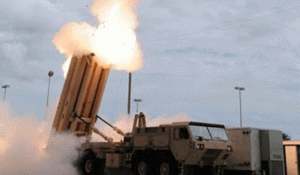
We need as well to put an end the separation of kinetic and non-kinetic capabilities as we rethink the future of weapons development enabled by the aerospace combat cloud.
Question: Obviously, what you are talking about embraces both rethinking joint as well as coalition perspectives. And this can embrace significant change in how we think about leveraging assets bought as a coalition. What is your perspective on the coalition possibilities?
Deptula: For example, if we take a consortium approach to security strategy we should consider the integrated application of capability resident in partner nations. We may be able to achieve much more capable outcomes than we otherwise achieve by pursuing traditional weapon system acquisition.
Question: This will lead as well to thinking about different concepts of operations to achieve mission objectives. What is your thinking on this challenge?
Deptula: We really need not just new conceptual constructs; we need to embrace truly joint organizational constructs that will actualize the combat cloud architecture. There needs to be a convergence of capability that will result in the design, development and actualization of a combat cloud by the different service components.
This is the challenge, but also the opportunity for a significant enhancement in 21st century relevant combat capabilities.
Robust, reliable anti-jam, anti-tamper methods of communication are key elements of the effort.
I do not just limit this to, I should say, methods of communication as opposed to links because there are ways to share information without relying on traditional links, and that will be part of the combat cloud design function as it evolves.
Again this concept is not just based on technology. It is also based on organization and the distribution of knowledge and understanding of guidance for how individual units might play so that you can have graceful degradation if the entire system is not operating with 100 percent contribution of each element.
In other words, it is not just about data-links or net-centricity, it is about a concept where even if you have degradation of your optimal information sharing construct you are still operating in a venue where you are very, very effective.
Deptula then went on to develop these propositions in various speeches over the past few months and this appendix has pulled together several of these propositions into a single statement.
Appendix: Lt. General (Retired) Deptula: An Assessment of the Nature and Importance of the Evolving Aerospace Combat Cloud
The U.S. military is now at a juncture where the speed of information, advances in stealth and precision strike, next-generation sensors, and other technologies will permit it to move beyond a combined arms warfare construct of segregated land, air, and sea operations.
This shift will not come easy, as many in the U.S. military have been inculcated with a belief in the combined arms approach and, in some cases, continue to adhere to the anachronistic belief that airpower should only be used as a supporting arm of land and sea operations.
In lieu of adhering to linear, industrial age operational approaches that mass forces to wage wars of attrition, DoD could create a new joint operational concept for combined effects warfare that integrates the functions of ISR, precision strike, maneuver, and sustainment to achieve desired effects across all operating domains.
The new Ford carrier will carry new capabilities into joint and coalition operations, which can be leveraged to augment the crafting, and augmentation of the aerospace combat cloud, notably significant server and electrical power capabilities to support the distributed force. Credit: Navy Media Content Services. 11/8/13
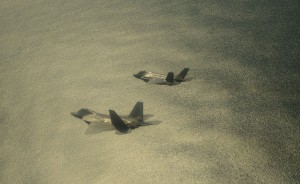
The future needs an agile operational framework for the integrated employment of allied military power. It means taking the next step in shifting away from a structure of segregated land, air or sea warfare that has come to be know as combined arms warfare, to integrated operations based on the four functions of ISR, strike, maneuver, and sustainment to achieve desired effects—or combined effects warfare.
We’re at a critical juncture in history—at the center of an Information in War Revolution—one where the speed of information, advance of technology, and designs of organizations are merging to change the way we operate. This change has dramatically shortened decision and reaction times, and reduced the number of systems it takes to achieve desired effects.
However, we can fail to realize the full potential of airpower, based on how we look at it. Just as we label the F-22s and F-35s with a traditional naming convention as a fighter—even though they are much more than that—we tend to view remotely piloted aircraft in terms of how well they can observe and destroy targets. This is a combined arms perspective.
Airpower provides us much more than simply combined arms platforms. To fully exploit its versatility, we need to pay more attention to combined effects. This paradigm shift will not come easy, as thousands of years of history has inculcated us with a combined arms approach. But we know that precise targeting does not always give us precise effects. So we have to anticipate second, and third, and higher orders of effect in the employment of every aspect of airpower.
For example, look at the observer effect that remotely piloted aircraft have extended to modern warfare. The simple act of observation has caused strategic disruption of terrorist adversaries. When we observe an enemy—and they are aware of the precision effects that can be immediately employed when seen—we dramatically change their behavior.
We know that aerospace systems give us more tools, but they don’t automatically give us better answers. That’s why humans need to stay in the technology loop. We know remotely piloted aircraft provide us reams of ISR data, but we need real-time analytic processing to make better decisions.
Similarly, we need to anticipate threats beyond those posed by combined arms, because our adversaries use any available means at their disposal. A short list would include cyber attacks, crowd sourcing, and distributed command and control—online.
Desired effects should determine our engagement methods, and force application is only one of a spectrum of options. In fact, an effects-based approach is a springboard for better linking military, economic, information, and diplomatic instruments of power to conduct security strategy in depth.
If we focus on combined effects warfare—the end of strategy, rather than force-on-force—the traditional means to achieve it, what we have become accustomed to calling combined arms warfare—we can consider more effective ways to accomplish the same goal more quickly than in the past, with fewer resources, and most importantly, with fewer casualties.
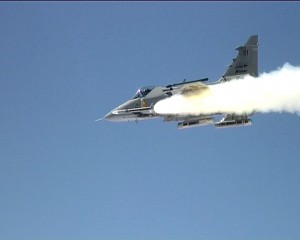
This joint concept should explain how the U.S. military could link information-age aerospace systems with sea and land-based weapons systems in ways that will enhance their combined effectiveness and compensate for the vulnerabilities of each.
A resulting ISR, strike, maneuver, and sustainment complex could be described as a “combat cloud” that uses information age technologies to conduct highly interconnected, distributed operations. The combat cloud concept is somewhat analogous to “cloud computing,” which is based on using a network (e.g., the Internet) to rapidly share information across a highly distributed system of systems.
Instead of combining the computing power of multiple servers, however, a combat cloud would capitalize on C4ISR networks to rapidly exchange data across an all-domain architecture of sensors and shooters to increase their effectiveness and achieve economies of scale.
If enabled by secure, jam/intrusion-proof connectivity, a combat cloud may be capable of employing fewer modern combat systems to achieve higher levels of effectiveness across larger areas of influence compared to legacy operational concepts.
For example, instead of relying on traditional approaches that mass fighters, bombers, and supporting aircraft into major strike packages to attack particular targets, a combat cloud could integrate complementary capabilities into a single, combined “weapons system” to conduct disaggregated, distributed operations over a fluid operational area.
A distributed, all-domain combat cloud that is difficult to attack effectively and nearly self-healing if attacked would also complicate an enemy’s planning and compel it to dedicate more resources toward its defense.
The “air combat cloud” requires treating and equipping every platform as a sensor as well as a “shooter” (defined as an ability to achieve a desired effect).
It will require a command and control (C2) paradigm that enables automatic linking as does cell-phone technology today (moving from one cell zone to another is transparent), and transfer of data seamlessly, and without need for human interaction within and/or between the air combat cloud nodes, plus it must be reliable, secure, and anti-jam proof.
We need to realize and exploit the advantages of modern aerospace and information age technology to build new cost-effective concepts of operation. However, one of our challenges is that people still tend to view cost in terms of individual unit cost, as opposed to cost per desired effect that better reflects real value—and that is where we need to move the discussion and decision space.
We need to realize and exploit the advantages of modern aerospace and information age technology to build new cost-effective concepts of operation. However, one of our challenges is that people still tend to view cost in terms of individual unit cost, as opposed to cost per desired effect that better reflects real value—and that is where we need to move the discussion and decision space.
We need to think beyond the constraints that traditional military culture imposes on new technology. For example, 5th generation aircraft such as the F-35 are termed “fighters,” but technologically, they are not just “fighters”—they are F-, A-, B-, E-, EA, RC, AWACS-35s. They are flying “sensor-strikers” that will allow us to conduct information age warfare inside contested battlespace whenever we desire—if we fully exploit their “non-traditional” capabilities to the degree that those capabilities become accepted as the new “traditional.
This will require leading-edge networking capabilities, and different approaches to solving our data bandwidth challenges. For example, to solve the explosion in data growth from new sensors, instead of building bigger pipes to transmit all the collected data, we ought to process the data on-board and only transmit what’s of interest to the users. This approach inverts the way we do intelligence, surveillance and reconnaissance processing today—and it has the potential for doing so quicker, better, and cheaper.
To fully capitalize on these capabilities will require a new way of designing our force. We need to also realize that innovation can be applied to organization as well as from technology. We have to think outside of the organizational constructs that history has etched into our collective psyche. Network-centric, interdependent, and functionally integrated operations are the keys to future military success.
Airpower allows us to do that. It can be intertwined with, and contribute to all elements of power—diplomatic, informational, military, economic and social. But it requires a broader perspective than traditionally applied to airpower in the past—beyond a supporting arm in the combined arms equation. We need to seek being able to integrate aerospace forces with each of these elements in an interdependent manner.
We need to link aerospace and information-age capabilities with sea and land-based means to create an omni-present defense complex that is self-forming, and if attacked, self-healing. This kind of a complex would be so difficult to disrupt that it would possess a conventional deterrent effect that would be stabilizing to whatever region it is deployed.
The central idea is cross-domain synergy. The complementary vice merely additive employment of capabilities in different domains such that each enhances the effectiveness, and compensates for the vulnerabilities, of the others.
This combined effects approach is about integrating existing and future aerospace capabilities within an agile operational framework guided by human understanding. It’s an intellectual construct with technological infrastructure.
And with regard to Team Tempest, see the following:
The Next Phase of Airpower Transformation for the UK: Putting Team Tempest in Perspective

